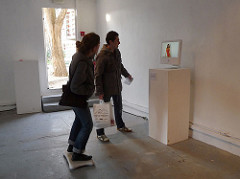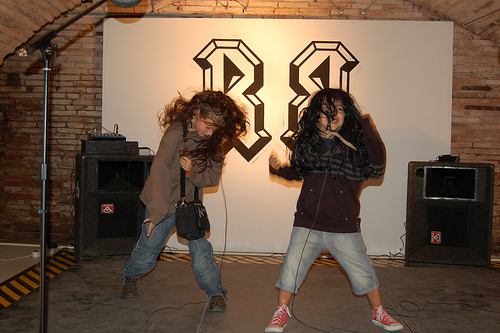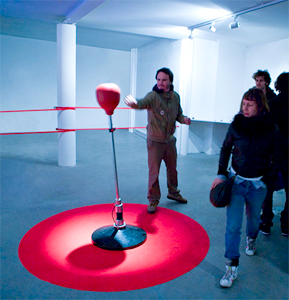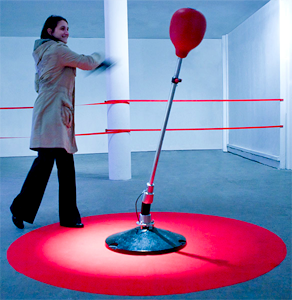- Exhibition: Festival Gamerz 04
- Curators: Isabelle Arvers, Quentin Destieu, Romain Senatore
- Production: M2F Créations / Dardex Mort2Faim
- Sites: La scène numérique (Seconde Nature), l’École supérieure d’art d’Aix-en-Provence, [Galérie Sextius](), Aix-en-Provence, France
- Dates: 6 January - 8 February 2009
- Time: 14h-19h
- Artists: Lionnel Scoccimaro (Fr), Axel Stockburger (At), France Cadet (Fr), Pascal Silondi (Cz), Colson Wood (USA) & Monsieur Moo (Fr), Antonin Fourneau (Fr), Collectif Dardex-Mort2faim (Fr), Ivan Chabanaud (Fr), Damien Berthier (Fr), Paul Destieu (Fr), Pierrick Thébault (Fr), Djeff Regottaz (Fr), Loïc Horellou (Fr), Manuel Braun (Fr), Virgine Le Gall (Fr), Fenshu (Uk), Confipop (Fr), Jane Antoniontti (Atelier hypermédia de l’Ecole Supérieure d’Art d’Aix-en-Provence), Florent Deloison (Atelier hypermédia), Projet I.M.M.E.D.I.A.T.E (Eu)
Some space was reserved yet again this year for the Atelier Hypermédia at the Festival Gamerz. Gamerz is a festival that explores the relationship between art & video games. This edition was co-curated by Isabelle Arvers who appears to be helping this promising little festival power up to the next level.
I’m a little late with this one, given that I was trapped in the snow in my little village for several days. I actually missed the opening and had to assist the last days of the Atelier Hypermédia’s contibution via lots of ftp and sms. Debugging and adjusting variables over cellular is not really my idea of fun, although it’s certainly not the first time. So I’ve only now been to the exhibit to actually see/document the works (and fix a couple bugs).
- Our first contribution is from Florent Deloison, a 5th year student at the school and who is presenting his installation « Recession Kid »: an 8-bit role-playing romp through the fun of mass-layoffs, offshore banking, slum landords, and free-wheeling stock market pimping. While the game harkens back to old-skool RPG’s, it adds some minor sophistications to the genre by indexing the gameplay to real-time fluctuations of various on-line data, ranging from live stock market values to weather conditions on wall street.


- The second installation is called « Twiist » and is a game from Jane Antoniotti which, while intended as a conceptual work, is actually quite fun to play. We built this one from the ground up in about three days when our previously planned installation went AWOL. Adding snow into the factor, I consider this quite a feat. Jane’s idea was to build a game using the Wii Balance Board, transforming it into an _un-_balanced board. Basically, during gameplay, the board periodically de-axes its center of gravity, and the player has to twist themselves into various improbable contorsions in order to re-produce, on screen, the ideal image of beauty. For Gamerz 04, Jane decided for a decidely Baywatch edition for the beauty model.
While making « Twiist », we wondered why Nintendo had never thought of this idea, for example by tying the Balance Board into their underwhelming Photo Channel. In the Atelier we were playing Flow on a Playstation 3 last week and were wondering, in a similar vein, why there aren’t any decent uses of the the Wiimote as simple and obvious as WiiPlay. Anyway, in Jane’s Twiist, the game was programmed to dynamically adjust to whatever photo is fed into it, and could easily be integrated with some simple OpenCV-style face detection + blob detection from within one’s own photo library. So any photo library could feasibly be fed into the game. There are in fact many potential variations to Jane’s game and would be pretty easy to program. Too bad we don’t have easy access to WiiWare (along the likes of the iPhone App Store, or even Microsoft’s XNA Creator’s Club), otherwise we would have been happy to port it to the real Wii. Again, the industry’s overprotective economic model is confounded with a contemporary version of shooting oneself in the foot. Nintendo has called one of their series « ArtStyle », with one of their games looking suprisingly similar to this old program created in 2004 in the Atelier by Yannick Aïvayan. Given that on rare occasions what we design is not so dissimilar, it makes no sense to me why we can’t distribute on that platform. But there you go, again: business models. But I’m rambling…
Of note: both games were built with Processing and Twiist uses Osculator to pull the data off the Balance Board and send it to Processing via Open Sound Control. For those looking to use the Balance Board, be careful of this little gem: early Balance Boards (April-May 2008) send their data out strangely and Osculator can register two of the four pads. This makes no sense of course, since the board works fine on the Wii itself, but there you go. Be forewarned. Camille Troillard, the creator of Osculator, has just sent me a beta test of the latest incarnation which fixes this problem. He is still testing, but my version works and on a balance board that previously worked incorrectly.
Also of note, both games use heavy doses of Polymorphism for more variation and evolution in the gameplay. Basically, if you are going to be doing any moderate to serious game design, you should know classes, objects, inheritance, and polymorphism. I have an old blog post on this subject.
Two other notable works at Gamerz, and from Atelier Hypermédia alumni to boot:
- Antonin Fourneau’s R+R (at the Galerie Sextius), a totally killer head-banging apparatus where you don a heavy-metal-approved wig, and violently bob your head up and down, provoking ear-splitting guitar riffs that (with the proper frenzy) pump it up to eleven.
- Manuel Braun and Virginie Le Gall’s « Fais-moi mal », a masochistic punching ball with an integrated speaker+accelerometer+arduino: as you punch the ball, the ball cries out for more. Probably one of the more gadgety installations by Manuel, but fun nevertheless and well-designed.
There are many other interesting installations, for example France Cadet’s Sweet Pads or Paul Destieu’s installation at the art school gallery which I can only describe as an autistic tennis match: the machine throwing and catching its own tennis ball, all day long. Er, uh, maybe that’s tautological tennis? Tennis recursion loop?
And finally, there appears to be a promising evening on January 28th with a contemporary take on the endlessly recycled ideas begun by Radúz Çinçera’s « Kinoautomat ». This time, the interface is your mobile phone: the film « E1000 » asks you to turn your cellphone on before the movie begins, and to use it in order to interact with the movie.








